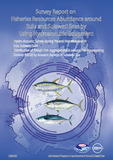Survey Report on Fisheries Resources Abundance Around Sulu and Sulawesi Seas by using Hydroacoustic Equipment
抄録
An acoustic survey was carried out from 25 October 2014 until 27 November 2014 for premonsoon season and 28 March 2015 until 1 May 2015 for post-monsoon season which covered all Sulu-Sulawesi Sea areas. The objective of the survey is to evaluate the small pelagic resources in Sulu Sulawesi Sea waters. The survey was conducted by using research vessel M.V.SEAFDEC2 that equipped with a scientific echo sounder FURUNO FQ80-M system. The survey was carried out covering a total area of approximately 327,420 km2. Raw data of back scattering strength from 130 transects were recorded by FQ80 Data Analyzer and then was analysed by FQ80 and MS Excel. Calculation for pelagic fish density was based on the dominant pelagic species for each leg. While, quantitative assessment to estimate for pelagic fish biomass was carried out by using the average density of pelagic fish at each transect. The dominant pelagic species observed during samplings were Rastrelliger kanagurta. The average density of pelagic fish in Sulu Sulawesi Sea in 2014 and 2015 were estimated at 2.80 MT/km2 and 2.88 MT/km2 respectively. The total pelagic fish biomass for Sulu Sulawesi Sea in 2014 and 2015 were estimated at 889,924 MT and 932,761 MT respectively. Estimated potential yield of pelagic fish for these two years were based on the natural mortality (M) of Rastrelliger kanagurta (1.23 year-1). Their estimated values were 279,129 MT in 2014 and 294,932 MT in 2015. There are significant different observed between density and temperature in 2015 and density with chlorophyll in 2014 (p>0.05).
Citation
SEAFDEC. (2017). Survey report on fisheries resources abundance around Sulu and Sulawesi Seas by using hydroacoustic equipment. Samut Prakarn, Thailand: Training Department, Southeast Asian Fisheries Development Center.
Collections
- Tunas [12]

